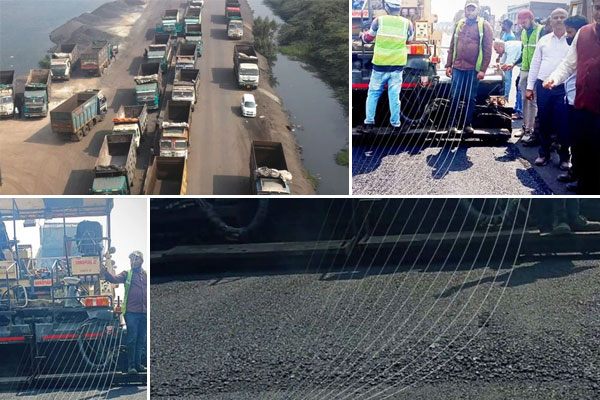The utilisation of waste as a construction material is being experimented with across the country. In the first such use case, waste steel has been utilised in India for constructing a road in Surat. A road made with steel waste has come up in the city of Surat in Gujarat at the Hazira Industrial Area. India’s first-ever ‘steel slag road’ was laid by ArcelorMittal Nippon Steel India in collaboration with CSIR India. Steel slag road is built with 100 percent processed steel slag, which aggregates in all layers of bituminous roads at Hazira, Surat. The slag is generated from a steel furnace burning at around 1,500-1,600 degrees centigrade in the form of molten flux material as an impurity. The molten material is poured into the slag pits for cooling as per the customised procedure and further processed to develop stable steel slag aggregates, with “better material properties in place of the natural aggregate commonly used in road constructions.
#Steelslag road built with 100 % processed steel slag aggregates in all layers of bituminous roads at Hazira, Surat in collaboration of @CSIRCRRI & @AMNSIndia under the R&D study sponsored by @SteelMinIndia. @NITIAayog @TATASTEEL @jswsteel @RinlVsp @NHAI_Official@CSIR_IND pic.twitter.com/dNHxxdnAZA
— CSIR CRRI (@CSIRCRRI) March 22, 2022
What is steel slag?
Steel slag, a by-product of steel making, is produced during the separation of the molten steel from impurities in steel-making furnaces. The slag occurs as a molten liquid melt and is a complex solution of silicates and oxides that solidifies on cooling.Virtually all steel is now made in integrated steel plants using a version of the basic oxygen process or in specialty steel plants (mini-mills) using an electric arc furnace process. There are many grades of steel that can be produced, and the properties of the steel slag can change significantly with each grade. Grades of steel can be classified as high, medium, and low, depending on the carbon content of the steel.
The project is executed jointly by the Council Of Scientific And Industrial Research (CSIR) and the Central Road Research Institute (CRRI) with help from the Ministry of Steel and Policy Commission and the NITI Aayog. The project also taps the Government of India’s Waste to Wealth and Clean India Campaign. According to CSRI, the thickness of the road has also been reduced by 30 percent. It is believed that this new method can prevent the roads from any damage caused during the monsoon season. This 1-kilometre-long road at Hazira Port in Gujarat was earlier in bad shape due to trucks carrying several tons of weight but under one experiment this road was made entirely from steel waste, now more than 1,000 trucks, 18 to 30 every day are passing with tons of weight, but the road remains the same according to CRRI Principal Scientist Satish Pandey.
Highlights of the project;
- The six-lane public road is a kilometre-long stretch in Hazira industries, which also houses the AM/NS plant.
- The road is made using 100 percent processed steel aggregate and substitutes for the usual material
- The construction began around a year ago by converting mounds of steel waste into steel slag aggregate.
- The sixth and final lane of the road, with a three-lane to-and-fro carriageway on either side, was completed in early March.
- The road is now being used by heavy-duty vehicles of multinationals located in the industrial estate on the outskirts of Surat.
Steel plants across India generate 19 million tonnes of steel waste every year and could grow to – according to one estimate – 50 million tonnes by 2030. Steel plants have become mountains of steel waste. This is a big threat to the environment, that is why on the instructions of NITI Aayog, the Ministry of Steel gave us a project to use this waste for construction many years ago. And after research, scientists processed steel waste at AMNS Steel Plant in Surat and got the ballast prepared from steel waste according to Santosh M Mundhra, Executive Director, AMNS, said.
With the success of its first pilot project, the Government of India is planning to use steel waste in the construction of highways to make the roads stronger in the future. The CRRI will now prepare guidelines and specifications for the utilisation of steel slag in road construction. “The parameters and performance indicators will be incorporated in the road guidelines and will be given to Indian Road Congress, Ministry of Roads and Highways, to utilise steel slag for the constructions of national highways.



